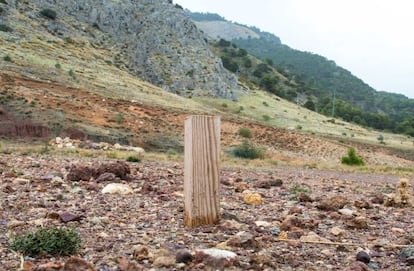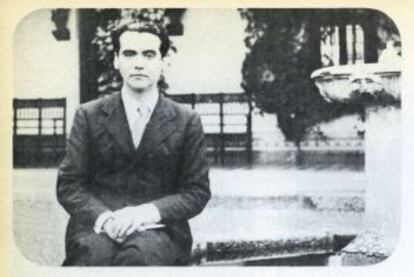“We don’t need to know how many shots they fired to kill Federico”
Third attempt to find where executioners buried body of Lorca in 1936 gets underway But family of Spanish poet want researchers to leave his remains alone if found


Archaeologist Javier Navarro believes that if he can locate the bones of a 1.68-meter-tall man, who had a foot defect and a larger than usual skull for his height, he will definitely have found the remains of poet Federico García Lorca.
Navarro is in charge of a new forensic team appointed by the Andalusia government that will lead a another search for the remains of the world-renowned Spanish playwright, who was shot by Franco’s Nationalists in 1936 and was later thought to have been buried in a common grave with others somewhere in a 160-meter radius of barren land in Alfacar (Granada).
If they find him, we will tell them to leave him right there”
Niece Laura García Lorca
This will be the third attempt to find his remains. But Lorca’s survivors, including his grandniece Laura, are already prepared to tell authorities what to do if they should ever find him.
“We will tell them to leave him right there,” she says. “It is the most logical thing to do.”
If the team was ever to find García Lorca – or the remains of Dióscoro Galindo, a republican teacher from Publiana, and anarchist banderilleros [bullfighter’s assistants] Juan Arcoya Cabezas and Francisco Galadí, who were all executed with him – it would be the beginning of a massive controversy.
One thing is finding the remains, and another thing is exhuming the bodies, which needs the permission of the families.
“Petitions for exhumations must come from direct family members – father, children and brothers – as well as from historical memory authorities and associations, who can act individually,” according to one source at the Andalusia government.
García Lorca’s survivors are his nieces and nephews, and they have all been against the search from the beginning.
“We respect everyone’s wishes to search for the remains of their families, but we are not going to support any such initiative for our own loved ones,” says niece Laura García Lorca, who heads up a foundation in her uncle’s memory.
“The fact that Federico García Lorca is buried together with the others is symbolically much stronger. They killed him the way they killed him, and that is history. He was buried in a common grave and because of this he shouldn’t have to be singled out from the rest.
“We believe it would be a lack of respect to the other victims to separate him from the others buried there. If one day they want to erect a monument, the names should be placed in alphabetic order,” the niece says.
Laura also launched strong criticism against those who insist on searching for the lost grave.

“What moves them is morbidity, fetishism and opportunity. Our family doesn’t need to know certain details, such as how many bullets they pumped into Federico. For us there are no doubts; it’s information that won’t change us in anyway.”
José María Lassalle, state secretary for culture at the Culture Ministry, says the central government will respect the family’s final decision.
“We will respect their wishes – whether they want to leave the remains where they are, or if they want them buried in a private ceremony, or even if they request to bring them to the pantheon of illustrious men. The state has an obligation to those who in their day were victims of a similar incidents,” says Lassalle.
In a locality watered by the Grande de Aynadamar Fountain, between the harsh cliffs softened with olive trees, which link the villages of Víznar and Alfacar by a winding walk, the residents await another dig in their area – but not without mixed feelings.
They don’t like their home to be known as the place where the poet’s violent execution occurred, or as the location where many hundreds of victims perished at the beginning of the Civil War.
Alfacar’s Socialist Mayor Fátima Gómez knows this well.
We will respect their wishes – whether they want to leave the remains where they are, or if they want them buried in a private ceremony”
Culture Ministry official José María Lassalle
“En Fuentevaqueros, they had the glory of seeing him born, but here, this is the disgraceful place where they killed him,” she says.
“This town will not permit anyone coming in to look for Lorca’s grave just because they want to. We have to look closely at what is behind this. There isn’t any problem if they are backed by strong scientific data,” says the mayor, who is active in Granada’s Historical Memory Association.
The first attempt to search for Lorca was made in 2009 based on the results of a lengthy investigation by renowned historian and Hispanist Ian Gibson, who has written extensively about Lorca. A second attempt came last year.
“I keep thinking that he is somewhere near the olive tree that is at the park entrance, but then again I didn’t come to this world to always be right in my judgements,” Gibson says. “I hope they find him. I am even willing to contribute to the global crowdfunding effort to raise money.
“The most important thing is to let them conclude their search.”
English version by Martin Delfín.
Hidden bones from the park
Among the clues that have popped up over the last few years were bones that were discovered in 1986.
When the Federico García Lorca Park was inaugurated in Alfacar in 2008, the daily Ideal published comments made by then-second vice chief of the Granada provincial government, Antonio Ernesto Molina Linares.
“We knew that if we were to build a park there, it was possible that the remains at one point would be found during the work, and that is what occurred,” he said.
Ian Gibson called Molina’s statements scandalous, saying they were “very serious affirmations.”
Carmen Vélez, who was mayor of Alfacar at the time said that “the important thing is that the bones were safe.”
Gibson has insisted that the bones should be recovered and analyzed to clear up all doubts.
Tu suscripción se está usando en otro dispositivo
¿Quieres añadir otro usuario a tu suscripción?
Si continúas leyendo en este dispositivo, no se podrá leer en el otro.
FlechaTu suscripción se está usando en otro dispositivo y solo puedes acceder a EL PAÍS desde un dispositivo a la vez.
Si quieres compartir tu cuenta, cambia tu suscripción a la modalidad Premium, así podrás añadir otro usuario. Cada uno accederá con su propia cuenta de email, lo que os permitirá personalizar vuestra experiencia en EL PAÍS.
¿Tienes una suscripción de empresa? Accede aquí para contratar más cuentas.
En el caso de no saber quién está usando tu cuenta, te recomendamos cambiar tu contraseña aquí.
Si decides continuar compartiendo tu cuenta, este mensaje se mostrará en tu dispositivo y en el de la otra persona que está usando tu cuenta de forma indefinida, afectando a tu experiencia de lectura. Puedes consultar aquí los términos y condiciones de la suscripción digital.
More information
Últimas noticias
The complicated life of Francesca Albanese: A rising figure in Italy but barred from every bank by Trump’s sanctions
Half of Scotland is in the hands of 420 property owners
Reinhard Genzel, Nobel laureate in physics: ‘One-minute videos will never give you the truth’
Pinochet’s victims grapple with José Antonio Kast’s rise in Chile
Most viewed
- Pablo Escobar’s hippos: A serious environmental problem, 40 years on
- Why we lost the habit of sleeping in two segments and how that changed our sense of time
- Charles Dubouloz, mountaineering star, retires at 36 with a farewell tour inspired by Walter Bonatti
- Reinhard Genzel, Nobel laureate in physics: ‘One-minute videos will never give you the truth’
- The Florida Keys tourist paradise is besieged by immigration agents: ‘We’ve never seen anything like this’









































